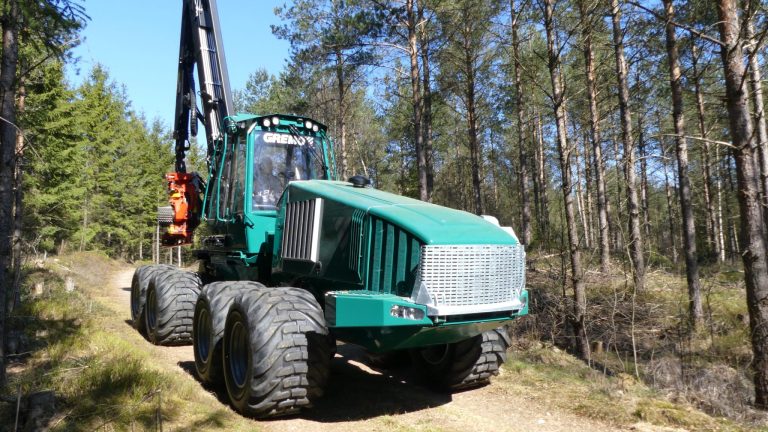The Swedish forest machine manufacturer Gremo in Ätran was a pioneer with 8-wheel harvesters several decades ago. When all other harvesters had six or four wheels, Gremo built the first with eight. In recent years, Gremo has worked hard on the development of it’s forwarder models, not least with the help of optimized steel materials selection to bring up payload index in the top among today’s thinning forwarders
Gremo’s harvester 1050H has been waiting for development, but just over a year ago, the company drew up the the guidelines for a new, modern and efficient thinning harvester. The plan was that the first machine would be built last year but lack of components and an overheated forest machine market delayed the plans. We wrote here at nordicwoodjournal.com about the first steps to build the new harvester and now, the first machine is built, started up, tested and out in the woods to cut its first trees. NordicWoodJournal.com went on a visit to the woods to get some pictures and video on the new Gremo 1058 harvester’s first days in production.
Same weight but more power in Gremo 1058 H5
Gremo’s new harvester is named Gremo 1058 H5 and it is considerably more than an upgrade of the old model. The most obvious difference is a much stronger Mesera (221H) crane and the machine also has a Stage V engine. But under the hood there are more differences. Crane and engine have increased in weight, but thanks to the fact that they have taken the material thinking from Gremo’s forwarder, it has been possible to keep the weight on the chassis down. This means that the 1058 H5 weighs like the old Gremos harvester 1050H despite increasing both crane strength and engine torque. Maintaining machine weight has otherwise not directly been the norm when the CTL manufacturers have upgraded their model programs…
Lower center of gravity
The engine frame has been redesigned to bring down the center of gravity. The fuel tank and part of the hydraulic tank are located at the bottom of the frame and the compact Cummins engine is low mounted. All radiators and fans have been mounted sideways and placed at the front (towards the cab) on the engine frame. The air is sucked in from the outside and then led backwards past the engine and the various stages of the exhaust cleaning that have been placed behind the engine, at the rear (in the nose). The bonnet has been trimmed down and slopes backwards, which gives a better view closer to the machine.
More view around the crane
The Mesera crane has the swivel cylinders placed across the machine, which gives a better tilt angle. The crane is low mounted on the frame with clean hose routings and there is considerably better visibility forward compared to the previous harvester model. The driver has almost 100% overview of the wheels. The cabin is the same as in the previous model, but it is considerably quieter in the cab when fans and engine part are better defined.
Stronger crane
I talked to the test pilot Mattias Schough at Krogsered Skogsentreprenad who runs one of Gremo’s older harvester 1050H for everyday use. He is in his fifth Gremos harvester and can compare how the new one performs. The most noticeable difference according to Mattias is the increased strength and lifting force of the crane. The Mesera crane easily lifts the SP 461 head with trees in full crane length and it’s fast and precise in the movements. Despite the fact that Gremo did not increase the machine weight, the harvester stands firmly on the ground at full reach thanks to a lower center of gravity and full locking of joints and bogies. The first machine has a 10-meter (32 ft) crane and will eventually go to a forest machine operator school. Coming machines will probably have Mesera’s 11-meter (36 ft) crane instead.
Same width
The machine has the same outer dimensions as the old harvester. With 700 wheels, the standard width is 278 cm (9 ft, 1 in) but can be further widened to 286 cm (9 ft, 4 in), to allow extra wide tracks for those who operate on soft ground conditions.
Cummins Engine
Like the other Gremo machines, the new Gremo harvester has a Cummins engine. This is the first machine to be built by Gremo with Stage V engine, but during the year the first forwarder with Stage V will also be built. The engine is a Cummins QSB Stage V and it has 200 HP and a torque of 1150 kN at 13-1400 rpm which is 20% higher than the previous model had (950 kN).
Thinning Harvester
The first 1058 H5 harvester has SP’s smallest head SP 461 LF and it will probably be the most common even if the harvester now, with the larger crane also can handle a 561 head.
The goal has been to build an efficient, reliable and economical machine that fits the southern Swedish forests and in areas with similar conditions. A machine with good user economy and which is more than competitive with similar thinning harvesters.
Manufacturing of the Gremo 1058 starts in late 2019
Serial production of Gremo 1058 H5 is planned to be started during the late autumn for delivery of the first harvesters in the end of this year.
Six-wheeled Gremo?
I asked what the 8th in 1058 means and then Martin Bredenfeldt from Gremo replied a bit cryptically that if you specify how many wheels the machine has in the model designation then you can replace the 8th with a 6th. If you want …
Here is a video showing the new harvester:












